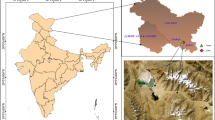Abstract
The results of a study of the light chestnut soil of an ampelocenosis located in a zone with a semi-desert-steppe regime and a low hydrothermal coefficient are presented. Analysis of the chemical composition revealed that the soil is nonsaline, saturated with bases, and deficient in individual plant nutrients. The study of the taxonomic composition of yeasts, which can act as a model group of microorganisms in the study of soil-microbiological processes, has shown the ability of this soil to play the role of a biological reservoir for storage and distribution in the natural cycle of various physiological groups of yeasts. The yeast complex included 11 species: 2 basidiomycetes and 9 ascomycetes. The yeasts Aureobasidium pullulans and Lachancea thermotolerans were significantly dominant. The yeasts were isolated by a direct plating and enrichment cultivation; the species identification of pure cultures was based on the analysis of the nucleotide sequences of the rDNA region. The accumulation of allochthonous yeasts, as well as other groups of microorganisms, influencing the biodiversity of the ampelocenosis soil, expands the potential for the participation of mycobiota in soil processes.
Similar content being viewed by others
REFERENCES
Abdullabekova, D.A., Magomedova, E.S., Magomedov, G.G., Aliverdieva, D.A., and Kachalkin, A.V., Yeast communities of chestnut soils under vineyards in Dagestan, Eurasian Soil Sci., 2017, vol. 50, no. 12, pp. 1463–1467.
Adzhiev, A.M., Vinogradorstvo Dagestana (Viticulture in Dagestan), Makhachkala: Dagest. Knizhn. Izd., 2009.
Adzhiev, A.M., Balamirzoev, M.A., Mirzoev, E.M.-R., Magomedov, A.Kh., Gasanov, G.N., Zalibekov, Z.G., and Gasanov, G.U., Pochvennye resursy Dagestana, ikh okhrana i ratsional’noe ispol’zovanie (Soil Resources of Dagestan: Protection and Rational Use), Makhachkala: Minist. Sel. Khoz., Resp. Dagest., 1998.
Allakhverdiev, S.R. and Eroshenko, V.I., Modern technologies in organic land agriculture, Mezhdunar. Zh. Prikl. Fundam. Issled., 2017, no. 1, pp. 76–79.
Arinushkina, E.V., Rukovodstvo po khimicheskomu analizu pochv (Practical Manual on Chemical Analysis of Soils), Moscow: Mosk. Gos. Univ., 1970.
Aristovskaya, T.V., Mikrobiologiya protsessov pochvoobrazovaniya (Microbiology of Pedogenic Processes), Moscow: Nauka, 1980.
Bab’eva, I.P. and Golovleva, L.A., Yeast flora in the main soil types of the European part of USSR, in Mikroorganizmy v sel’skom khoziyaistve (Microorganisms in Agriculture), Moscow: Mosk. Gos. Univ., 1963, pp. 231–251.
Blinov, V.A., Burhsina, S.M., and Shapulina, E.A., Biological action of effective microorganisms, in Biologicheskie preparaty. Sel’skoe khozyaistvo. Ekologiya: Praktika primeneniya (Biological Preparations, Agriculture, and Ecology: Application), Moscow: EM-Kooperatsiya, 2008, pp. 30–67.
Boretsky, Y.R., Protchenko, O.V., Prokopiv, T.M., Mukalov, I.O., Fedorovych, D.V., and Sibirny, A.A., Mutations and environmental factors affecting regulation of riboflavin synthesis and iron assimilation also cause oxidative stress in the yeast Pichia guilliermondii, J. Basic Microbiol., 2007, vol. 47, no. 5, pp. 371–377.
Chernov, I.Yu., Drozhzhi v prirode (Yeast in Nature), Moscow: KMK, 2013.
Di Menna, M.E., Yeasts in New Zealand soils, N. Z. J. Bot., 1965, vol. 3, pp. 194–203.
Fedotov, G.N., Shoba, S.A., Fedotova, M.F., Stepanov, A.L., and Streletsky, R.A., Soil yeasts and their role in seed germination, Eurasian Soil Sci., 2017, vol. 50, no. 5, pp. 573–579.
Ganzha, N.F., Pochvovedenie (Soil Science), Moscow: Agrokonsalt, 2001.
Hagler, A.N., Yeasts as indicators of environmental quality, in Biodiversity and Ecophysiology of Yeasts. The Yeast Handbook, Rosa, C.A. and Péter, G., Eds., New York: Springer-Verlag, 2006, pp. 515–532.
Kirilyuk, V.P., Trace elements in the system soil-grape plant in the central Moldova, Extended Abstract of Cand. Sci. (Biol.) Dissertation, Moscow, 1981.
Koval’skii, V.V. and Andrianova, G.A., Mikroelementy v pochvakh SSSR (Trace Elements in Soils of USSR), Moscow: Nauka, 1970.
Kratkaya khimicheskaya entsiklopediya. Tom 4. Pirometallurgiya (Brief Chemical Encyclopedia, Vol. 4: Pyrometallurgy), Knunyants, N.L., Ed., Moscow: Sovetskaya Entsiklopediya, 1965, pp. 282–283.
Kravchenko, A.N., Guber, A.K., Razavi, B.S., Koestel, J., Blagodatskaya, E.V., and Kuzyakov, Y., Spatial patterns of extracellular enzymes: combining X-ray computed micro-tomography and 2D zymography, Soil Biol. Biochem., 2019, vol. 135, pp. 411–419.
Kruglov, Yu.V., Microbial community in soil: physiological diversity and study methods. A review, S-kh. Biol., 2016, vol. 51, no. 1, pp. 46–59.
Kurtzman, C.P., Fell, J.W., and Boekhout, T., The Yeasts: A Taxonomic Study, Amsterdam: Elsevier, 2011, 5th ed.
Leathers, T.D., Bioconversions of maize residues to value-added coproducts using yeast-like fungi, FEMS Yeast Res., 2003, vol. 3, no. 2, pp. 133–140.
Metodicheskie ukazaniya po provedeniyu kompleksnogo monitoringa plodorodiya pochv zemel’ sel’skokhozyaistvennogo naznacheniya (Recommendations for Complex Fertility Monitoring of Agricultural Soils), Moscow: Rosinformagrotekh, 2003.
Mineev, V.G., Praktikum po agrokhimii (Practical Manual on Agrochemistry), Moscow: Mosk. Gos. Univ., 2001, 2nd ed.
MycoBank Database, Fungal databases, nomenclature, and species banks, 2020. http://mycobank.org. Accessed January 20, 2020.
National Center for Biotechnology Information, 2020. https://www.ncbi.nlm.nih.gov. Accessed January 20, 2020.
Onishi, H. and Suzuki, T., Microbial production of xylitol from glucose, J. Appl. Microbiol., 1969, vol. 18, no. 6, pp. 1031–1035.
Sibirny, A.A., Pichia guilliermondii, in Nonconventional Yeasts in Biotechnology, Wolf, K., Ed., Heidelberg: Springer-Verlag, 1996, pp. 255–275.
Smirnova, I.E., Sadanov, A.K., Nurmukhanbetova, A.M., and Sultanova, A.Zh., The effect of the association of agronomically valuable microorganisms on the microflora of degraded soils, Mezhdunar. Zh. Prikl. Fundam. Issled., 2017, no. 1, pp. 92–96.
Voronin, A.D., Osnovy fiziki pochv (Principles of Soil Physics), Moscow: Mosk. Gos. Univ., 1986.
Zvyagintsev, D.G., Vzaimodeistvie mikroorganizmov s tverdymi poverkhnostyami (Interaction of Microorganisms with Solid Surfaces), Moscow: Mosk. Gos. Univ., 1973.
Zvyagintsev, D.G., Pochva i mikroorganizmy (Soil and Microorganisms), Moscow: Mosk. Gos. Univ., 1987.
Funding
This work was supported by the Russian Foundation for Basic Research, project no. 12-04-01222 and the Russian Science Foundation, no. 19-74-10 002 (works on yeasts identification).
Author information
Authors and Affiliations
Corresponding authors
Ethics declarations
Conflict of interests. The authors declare that they have no conflicts of interest.
Statement on the welfare of humans or animals. This article does not contain any studies involving animals performed by any of the authors.
Rights and permissions
About this article
Cite this article
Abdullabekova, D.A., Magomedova, E.S., Magomedov, G.G. et al. Yeasts as an Element of Ampelocenosis Soil Biodiversity in an Arid Climate. Arid Ecosyst 11, 299–303 (2021). https://doi.org/10.1134/S2079096121030021
Received:
Revised:
Accepted:
Published:
Issue Date:
DOI: https://doi.org/10.1134/S2079096121030021




